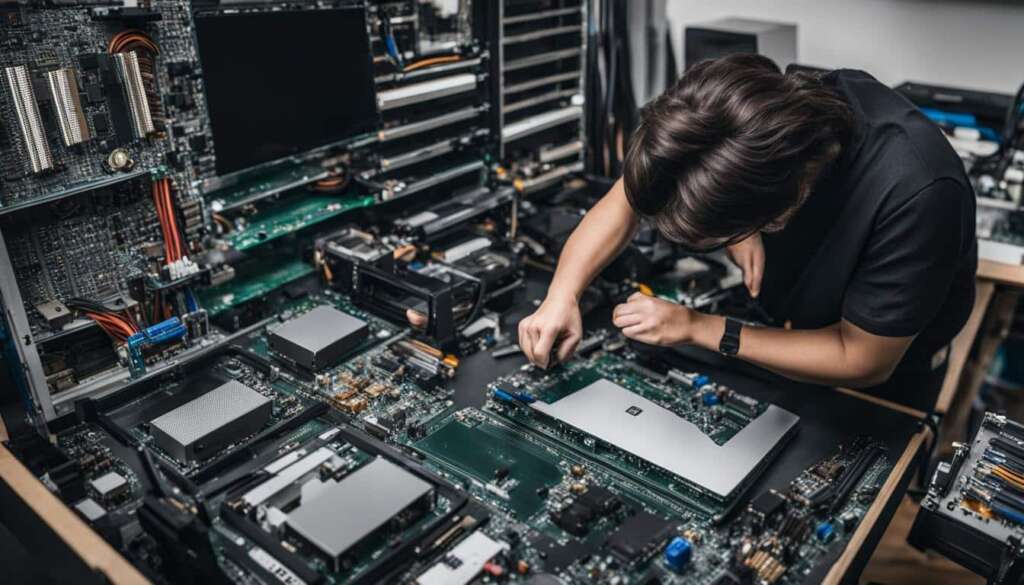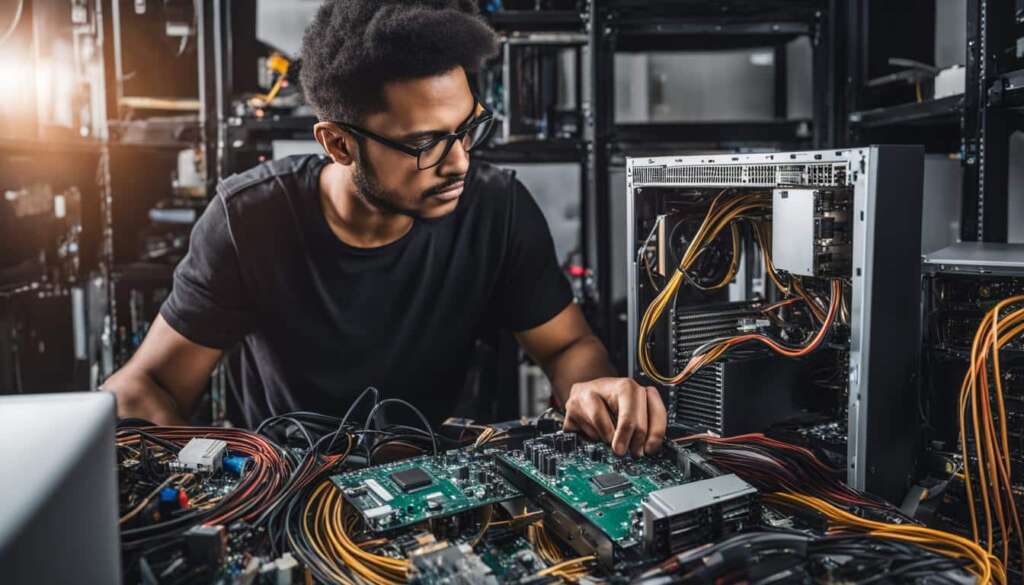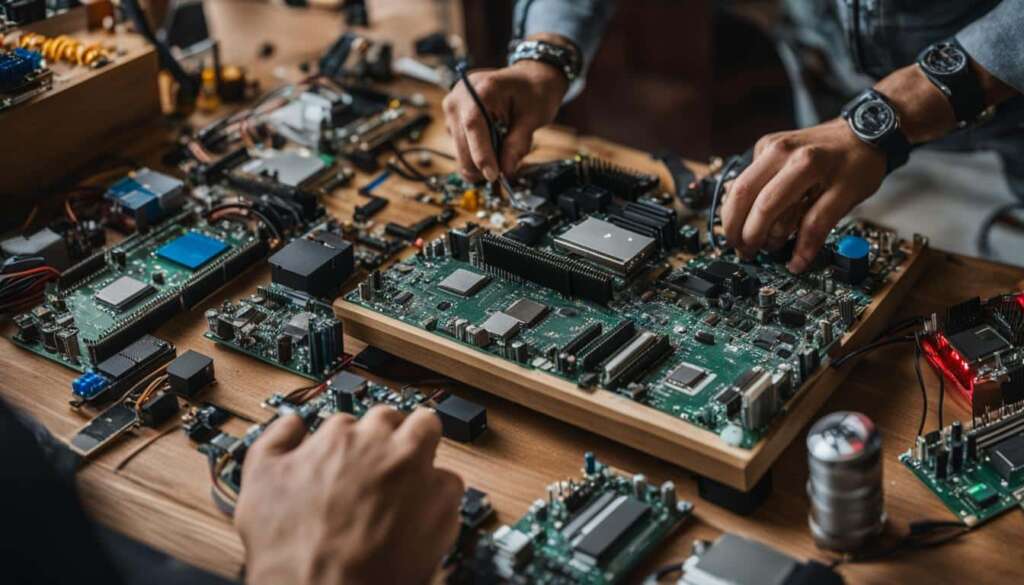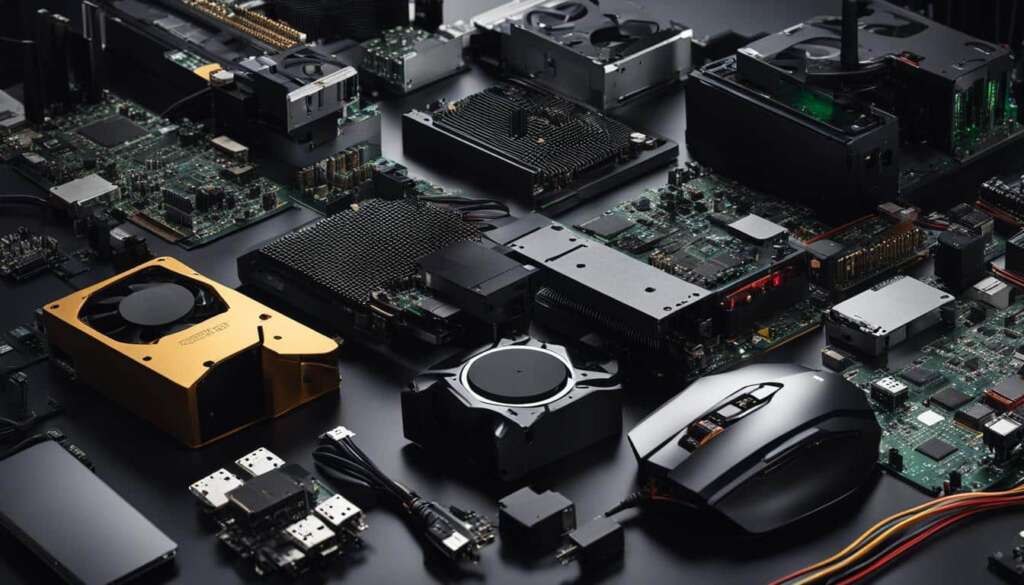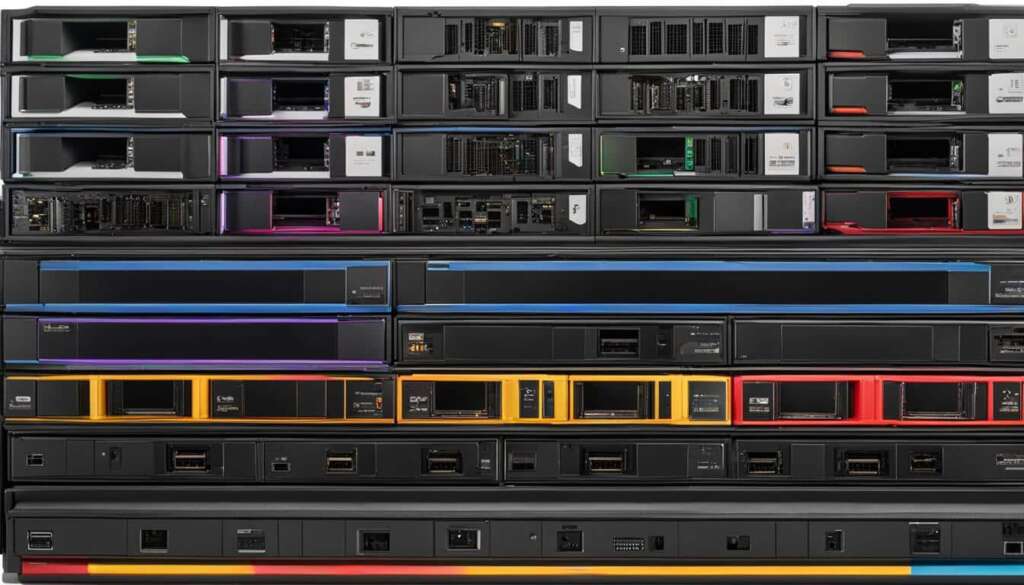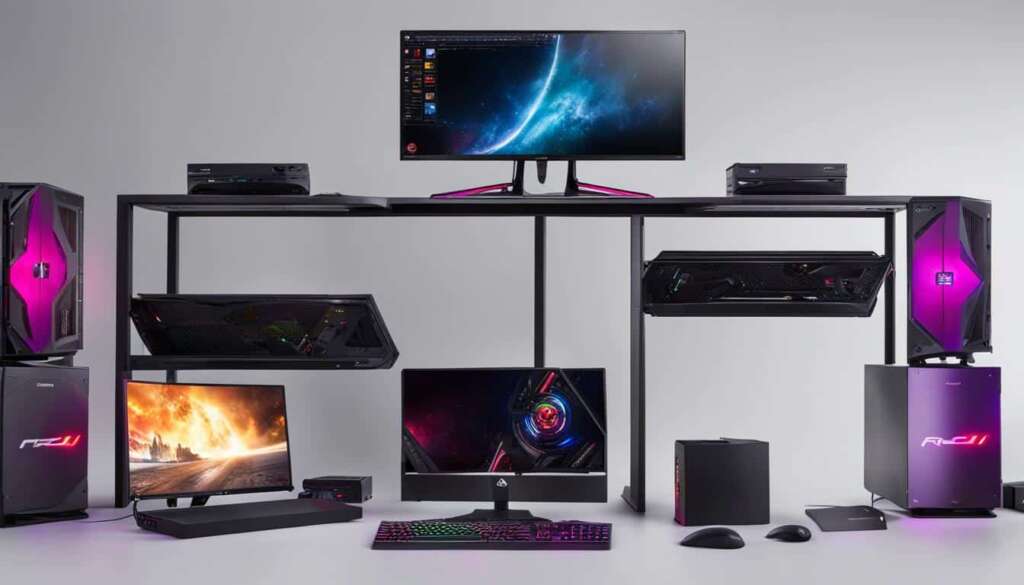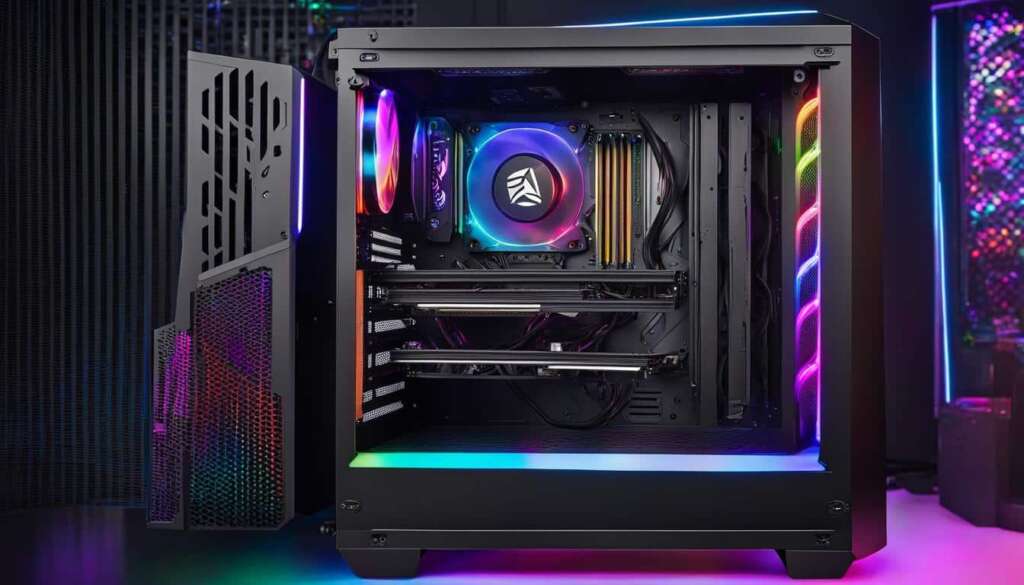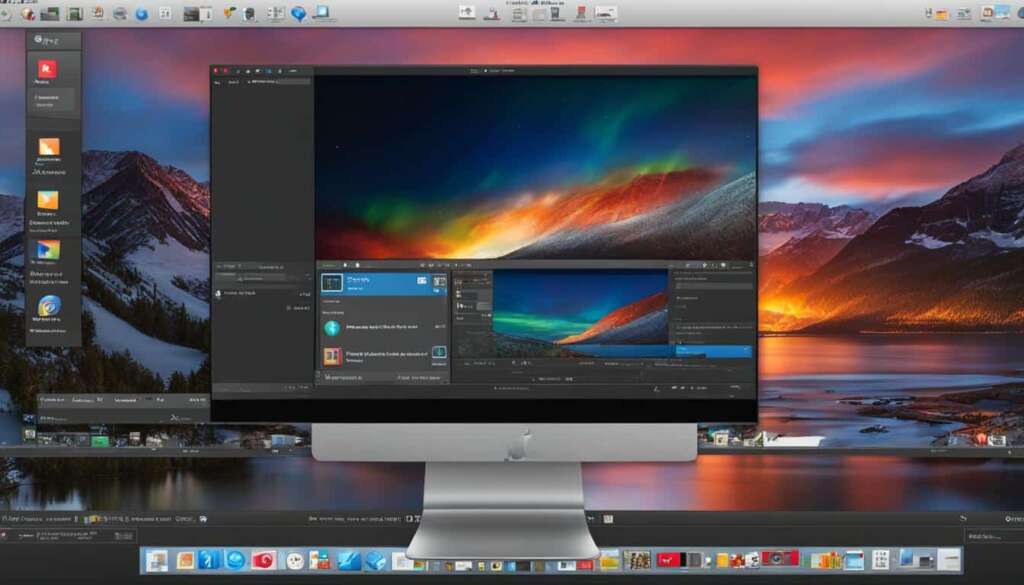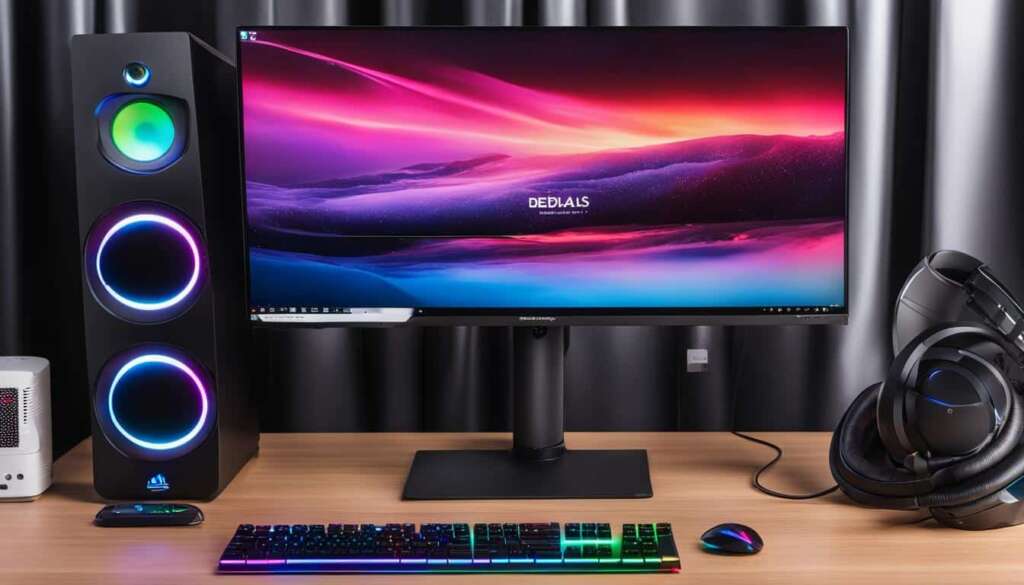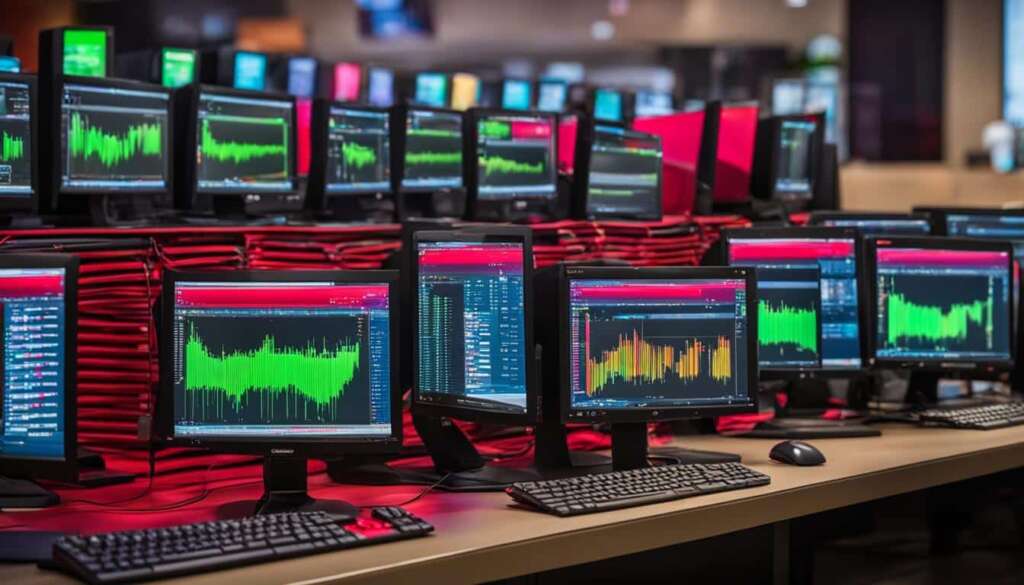Table of Contents
Building your own desktop PC may seem daunting, but with basic instructions and the confidence to use a screwdriver, anyone can do it. Building a PC is similar to assembling furniture from IKEA, and it allows you to select the right parts for a customized experience. This comprehensive guide will provide you with the context and steps necessary to build your own PC, covering everything from component selection to the actual assembly process.
Key Takeaways:
- Building your own PC allows for customization and the selection of the best components for your needs.
- Choosing the right components, such as the PC case, motherboard, CPU, and memory kit, is crucial for compatibility and performance.
- Considerations such as size, compatibility, and aesthetics come into play when selecting a PC case.
- The motherboard is the backbone of your PC, and its compatibility with other components is essential.
- The CPU, CPU cooler, and memory kit should be chosen carefully to ensure optimal performance.
Choosing the Key Components
When building a PC, it’s essential to select the right components that will ensure compatibility and optimal performance. Each component plays a crucial role in the assembly process, and understanding their requirements is vital. Let’s take a closer look at the key components you need to consider:
1. PC Case
The PC case or chassis serves as the foundation for your build, determining the size and configuration of your components. It’s important to choose a case that is compatible with your chosen motherboard and power supply. Consider factors such as size, shape, airflow, and the overall design aesthetics to create a visually appealing build.
2. Motherboard
The motherboard is the central component that connects and controls all other parts of your PC. When selecting a motherboard, it’s crucial to consider the socket type, chipset, form factor, and support for external ports and expansion slots. This ensures that your motherboard will be compatible with your chosen CPU and other components.
3. CPU and CPU Cooler
The CPU, or central processing unit, is the brain of your computer. It’s important to choose a CPU that is compatible with your motherboard and meets your performance requirements. Additionally, a CPU cooler is necessary to prevent overheating and maintain optimal temperature levels. Consider factors such as socket type, chip architecture, performance, and cooling capability when selecting both the CPU and CPU cooler.
4. Memory Kit
The memory kit, or RAM, is responsible for storing and accessing data quickly. It’s important to choose a memory kit that is compatible with your chosen motherboard and CPU. Consider factors such as memory speed, capacity, and support for overclocking to ensure smooth operation and optimal performance.
| Component | Considerations |
|---|---|
| PC Case | Size, shape, compatibility |
| Motherboard | Socket type, chipset, form factor, external ports |
| CPU | Socket type, chip architecture, performance |
| CPU Cooler | Cooling capability, compatibility |
| Memory Kit | Memory speed, capacity, overclocking support |
These key components lay the foundation for your PC build and can greatly impact its performance and compatibility. By carefully choosing each component and considering their specific requirements, you can ensure a smooth assembly process and a high-performing PC.
Selecting the PC Case
When building your own PC, one of the most important decisions you’ll make is selecting the right PC case. The case not only houses all your components but also determines the size and configuration of your build. It’s essential to choose a case that not only fits your components but also offers the necessary features and customization options.
Factors to consider when selecting a PC case include its size, shape, and compatibility with your chosen motherboard and power supply. Make sure to check the form factor supported by the case, such as ATX or micro ATX, and ensure it matches your motherboard’s specifications. Additionally, consider the number and type of expansion slots, ports, and drive bays available in the case to accommodate your future upgrade needs.
The aesthetics of the case are also important for many PC builders. Some cases offer tempered-glass sides, allowing you to showcase your components and create a visually stunning build. You can also explore options for customizable RGB lighting and cable management solutions to enhance the overall look and organization of your build.
Example: Corsair 4000D Airflow Case
One popular choice among PC builders is the Corsair 4000D Airflow case. This mid-tower case offers a spacious interior to accommodate high-performance components and efficient airflow to keep your system cool. With a minimalist design and a tempered-glass side panel, the 4000D Airflow provides a sleek look while allowing you to showcase your build.
The case features a modular design, making it easy to install components and customize the layout to suit your needs. It also offers ample room for cable management, ensuring a clean and organized build. The 4000D Airflow supports various motherboard form factors, including ATX and micro ATX, and comes with multiple fan mounting points and dust filters for optimal cooling and easy maintenance.
| Key Features of Corsair 4000D Airflow Case | Specifications |
|---|---|
| Form Factor | Mid-Tower |
| Supported Motherboard Form Factors | ATX, micro ATX |
| Expansion Slots | 7 |
| Drive Bays | 2 x 3.5″, 2 x 2.5″ |
| Front Panel Ports | 2 x USB 3.0, 1 x USB 3.1 Type-C, Audio In/Out |
| Cooling Options | Up to 6 fans, radiator support up to 360mm |
| Dimensions | 453mm x 230mm x 466mm |
With its impressive features and versatility, the Corsair 4000D Airflow case provides a solid foundation for your PC build, combining functionality and aesthetics to create a visually appealing and high-performance system.
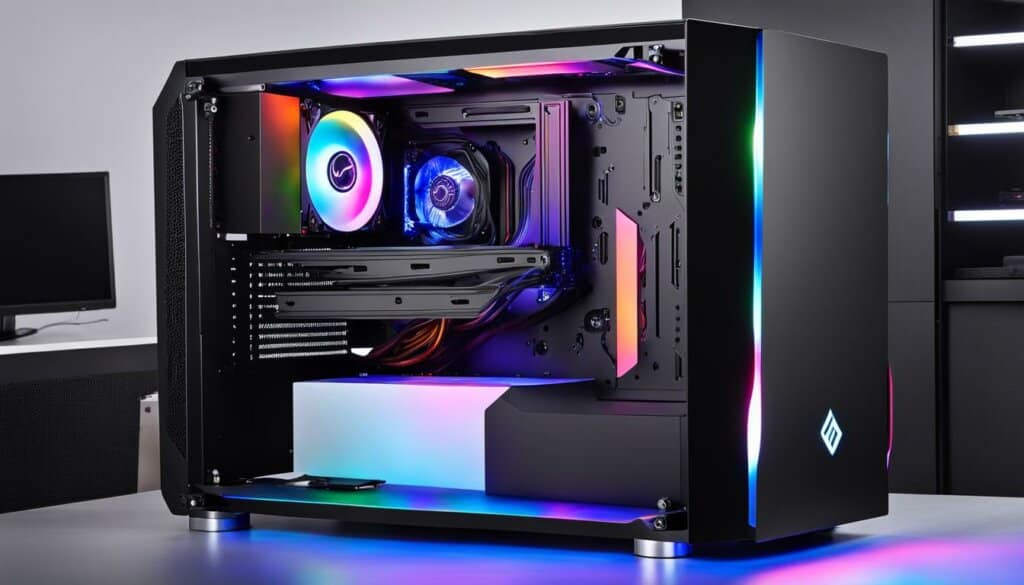
Choosing the Motherboard
When it comes to building a PC, selecting the right motherboard is of utmost importance. The motherboard serves as the foundation for all other components, ensuring compatibility and supporting their functionality. To help you make an informed decision, we will explore the factors to consider when choosing a motherboard.
Factors to Consider
- Socket Type: The socket type of the motherboard must match the CPU you plan to use. This ensures a proper fit and allows the CPU to communicate effectively with other components.
- Chipset: The chipset determines the motherboard’s capabilities, including the number of USB ports, expansion slots, and support for features such as overclocking and RAID.
- Form Factor: Consider the form factor that suits your needs and fits your chosen PC case. Common form factors include ATX, Micro-ATX, and Mini-ITX.
- External Ports and Expansion Slots: Ensure that the motherboard has sufficient USB ports, audio jacks, and expansion slots for your requirements. This includes considering the number of PCIe slots for graphics cards, additional storage, and other peripherals.
“Selecting the right motherboard is crucial for optimal performance and future scalability.”
The Asus Prime B660-Plus D4 motherboard is an excellent example of a reliable and feature-rich option. Designed for Intel 12th and 13th Generation CPUs, this motherboard offers extensive connectivity options, PCIe 4.0 support, and robust power delivery for enhanced performance.
By carefully considering these factors and choosing a motherboard that aligns with your specific needs and budget, you can ensure a smooth and efficient PC building experience.
| Socket Type | Chipset | Form Factor | External Ports | Expansion Slots |
|---|---|---|---|---|
| LGA 1200 | Intel B660 | ATX | 6 x USB 3.2 Gen 1, 2 x USB 2.0, 1 x HDMI, 1 x DisplayPort | 2 x PCIe 4.0 x16, 2 x PCIe 3.0 x1, 2 x M.2 slots |
| 5 x audio jacks, 1 x Ethernet port | 6 x SATA 6Gb/s ports |
Selecting the CPU and CPU Cooler
When it comes to building your own PC, selecting the right CPU and CPU cooler is essential for optimal performance and heat management. The CPU, or central processing unit, is the brain of your computer, responsible for executing instructions and performing calculations. It’s important to choose a CPU that meets your specific needs, whether you’re a casual gamer, a content creator, or a professional in need of high computing power.
One popular choice for CPU selection is the Intel Core i7-13700K processor. This powerful processor offers excellent gaming and productivity capabilities, with its high clock speeds and multiple cores. It’s compatible with the latest motherboards, ensuring future-proof compatibility and upgradeability. Whether you’re playing the latest AAA games or editing high-resolution videos, the i7-13700K offers the performance you need.
However, with great power comes a greater need for cooling. Hot-running CPUs like the i7-13700K require efficient cooling solutions to prevent overheating and maintain stable performance. That’s where a CPU cooler comes in. One recommended option is the Corsair H100i Elite liquid cooling kit. This all-in-one liquid cooler provides excellent heat dissipation, keeping your CPU temperatures in check even during intense gaming or demanding tasks.
By selecting the right CPU and CPU cooler, you can ensure optimal performance and longevity for your PC build. Take the time to research and compare different options, considering factors such as performance, compatibility, and budget. With the right combination, you’ll be able to enjoy a smooth and efficient computing experience.
Key Points:
- Selecting the right CPU is crucial for optimal performance and meeting specific needs.
- The Intel Core i7-13700K processor offers excellent gaming and productivity capabilities.
- A CPU cooler is essential for efficient heat management and preventing overheating.
- The Corsair H100i Elite liquid cooling kit is a recommended option for hot-running CPUs.
- Research and compare different options based on performance, compatibility, and budget.
| CPU | Intel Core i7-13700K |
|---|---|
| Cores | 8 |
| Threads | 16 |
| Base Clock Speed | 3.5 GHz |
| Max Turbo Boost Speed | 5.0 GHz |
| Socket Type | LGA 1700 |
Selecting the Memory Kit
When it comes to building your own PC, selecting the right memory kit is essential for optimal performance. The memory, also known as RAM (Random Access Memory), plays a crucial role in the smooth operation of your computer. It stores data that is actively being used by the CPU, allowing for faster access and multitasking capabilities. In this section, we will explore the key factors to consider when choosing a memory kit for your PC.
Factors to Consider
When selecting a memory kit, one of the most important factors to consider is compatibility. Ensure that the memory kit is compatible with your chosen CPU and motherboard. Check the specifications of your CPU and motherboard for supported memory types, speeds, and capacity. It’s also important to consider the number of memory slots available on your motherboard and the maximum capacity it can support.
In addition to compatibility, you should also consider the memory speed. Memory speed is measured in megahertz (MHz) and indicates the rate at which data can be read from and written to the memory. Higher memory speeds can result in faster data transfers and improved overall performance. However, keep in mind that the maximum supported memory speed may be determined by the capabilities of your CPU and motherboard.
Recommended Memory Sizes
The recommended minimum RAM size for a gaming PC is 16GB. This allows for smooth gameplay and multitasking capabilities. If you are into video editing or other resource-intensive tasks, it is recommended to have at least 32GB of RAM to ensure optimal performance. However, it’s important to consider your budget and specific needs when deciding on the size of your memory kit.
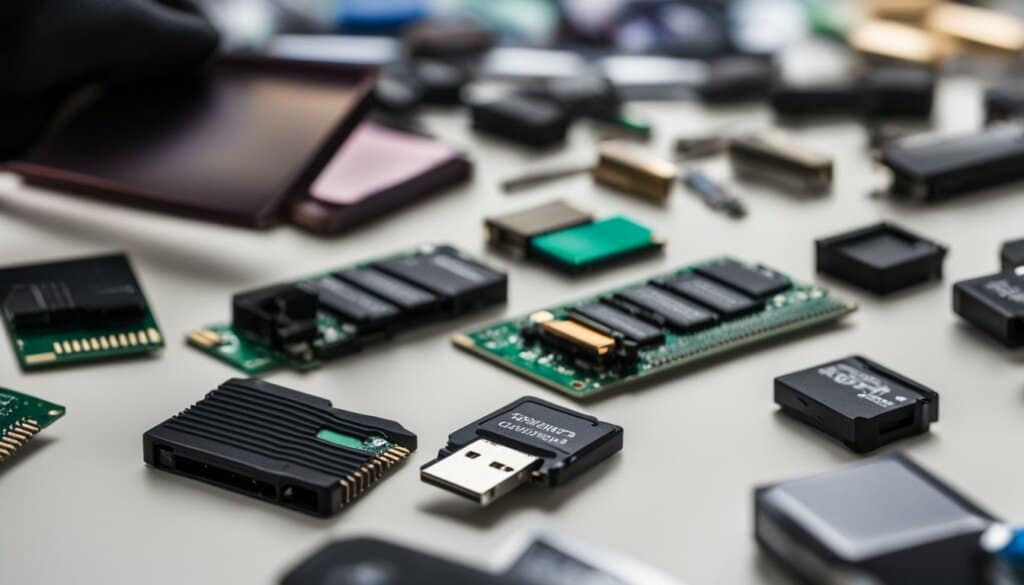
Summary
When selecting a memory kit for your PC, consider compatibility with your CPU and motherboard, memory speed, and the recommended size for your specific needs. By carefully choosing the right memory kit, you can ensure smooth operation and optimal performance for your custom-built PC.
Conclusion
Building your own PC can be a rewarding and fulfilling experience, allowing you to tailor your machine to your specific needs and preferences. This comprehensive guide has provided you with valuable insights into the PC building process, from component selection to assembly. By following the steps outlined in this tutorial, you can embark on a journey of customization and performance optimization, creating a custom PC build that suits your requirements.
It is important to note that PC builds may vary based on personal preferences and budget constraints. While this guide covers the basic principles of PC building, there is always room for creativity and individuality. Feel free to explore different options and consult online resources to enhance your knowledge and skills in building a custom PC.
Remember, patience and attention to detail are key throughout the process. Take your time to research and understand each component’s specifications, ensuring compatibility and performance. Whether you are a gaming enthusiast, a content creator, or simply someone looking for a unique computing experience, building your own PC can be a deeply satisfying and empowering endeavor.
Happy building and enjoy your custom PC!
FAQ
Is building a PC difficult?
Building a PC may seem daunting at first, but with basic instructions and the confidence to use a screwdriver, anyone can do it. It’s similar to assembling furniture from IKEA.
What are the key components to consider when building a PC?
The key components to consider when building a PC include the PC case, motherboard, CPU and CPU cooler, memory kit, storage, power supply, and monitor.
How do I choose the right PC case?
Factors to consider when choosing a PC case include its size, shape, and compatibility with your chosen motherboard and power supply. You can also consider customization options like tempered-glass sides and coordinated aesthetics.
What should I consider when selecting a motherboard?
When selecting a motherboard, you should consider the socket type, chipset, form factor, and support for external ports and expansion slots. Compatibility with your chosen CPU is crucial.
How do I choose the right CPU and CPU cooler?
Factors to consider when choosing a CPU include socket type, chip architecture, performance, and power consumption. It’s important to select a CPU that is compatible with your chosen motherboard. For hot-running CPUs, like the i7-13700K, a CPU cooler, such as the Corsair H100i Elite liquid cooling kit, is recommended for optimal cooling performance.
What should I consider when selecting a memory kit?
When selecting a memory kit, or RAM, you should consider compatibility with your chosen CPU and motherboard, peak memory speeds, and support for overclocking. The recommended minimum RAM size for a gaming PC is 16GB.
Can anyone build their own PC?
Yes, by following the steps outlined in this guide and taking advantage of the resources available online, anyone can successfully build their own PC and customize it to their specific needs and preferences.

